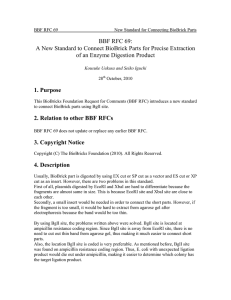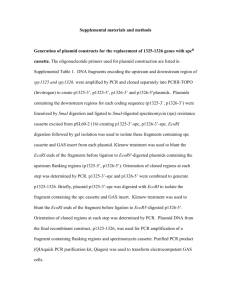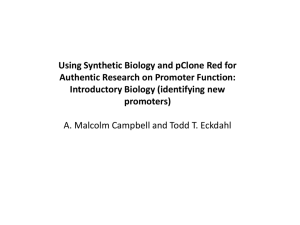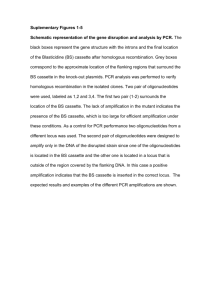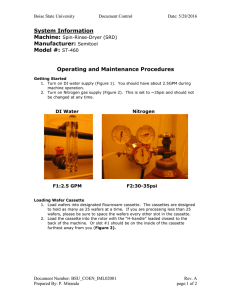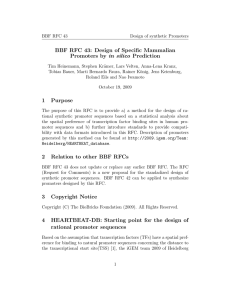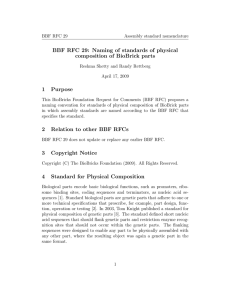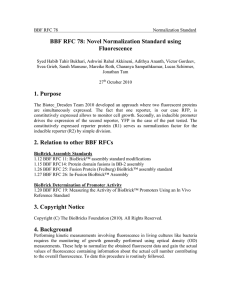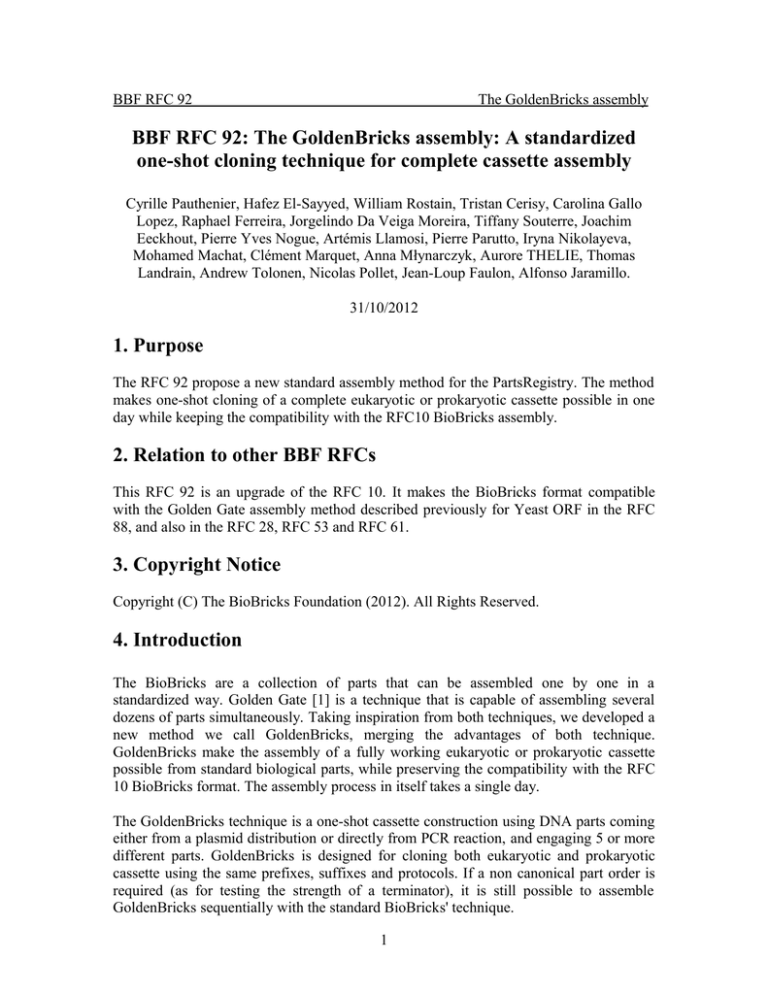
BBF RFC 92
The GoldenBricks assembly
BBF RFC 92: The GoldenBricks assembly: A standardized
one-shot cloning technique for complete cassette assembly
Cyrille Pauthenier, Hafez El-Sayyed, William Rostain, Tristan Cerisy, Carolina Gallo
Lopez, Raphael Ferreira, Jorgelindo Da Veiga Moreira, Tiffany Souterre, Joachim
Eeckhout, Pierre Yves Nogue, Artémis Llamosi, Pierre Parutto, Iryna Nikolayeva,
Mohamed Machat, Clément Marquet, Anna Młynarczyk, Aurore THELIE, Thomas
Landrain, Andrew Tolonen, Nicolas Pollet, Jean-Loup Faulon, Alfonso Jaramillo.
31/10/2012
1. Purpose
The RFC 92 propose a new standard assembly method for the PartsRegistry. The method
makes one-shot cloning of a complete eukaryotic or prokaryotic cassette possible in one
day while keeping the compatibility with the RFC10 BioBricks assembly.
2. Relation to other BBF RFCs
This RFC 92 is an upgrade of the RFC 10. It makes the BioBricks format compatible
with the Golden Gate assembly method described previously for Yeast ORF in the RFC
88, and also in the RFC 28, RFC 53 and RFC 61.
3. Copyright Notice
Copyright (C) The BioBricks Foundation (2012). All Rights Reserved.
4. Introduction
The BioBricks are a collection of parts that can be assembled one by one in a
standardized way. Golden Gate [1] is a technique that is capable of assembling several
dozens of parts simultaneously. Taking inspiration from both techniques, we developed a
new method we call GoldenBricks, merging the advantages of both technique.
GoldenBricks make the assembly of a fully working eukaryotic or prokaryotic cassette
possible from standard biological parts, while preserving the compatibility with the RFC
10 BioBricks format. The assembly process in itself takes a single day.
The GoldenBricks technique is a one-shot cassette construction using DNA parts coming
either from a plasmid distribution or directly from PCR reaction, and engaging 5 or more
different parts. GoldenBricks is designed for cloning both eukaryotic and prokaryotic
cassette using the same prefixes, suffixes and protocols. If a non canonical part order is
required (as for testing the strength of a terminator), it is still possible to assemble
GoldenBricks sequentially with the standard BioBricks' technique.
1
BBF RFC 92
The GoldenBricks assembly
GoldenBricks opens new perspectives for the PartsRegistry. It is faster, cheaper and safer
and requires less sequencing runs than BioBrick RFC10 assembly. It is designed to be an
efficient cloning techniques for researchers and companies but is also more suitable for
less experimented users, such as iGEMers, high school iGEMers or the DIYbio
community. The creation of large expression cassettes is up to now cheaper and faster
than synthesizing the construct, which would guaranty the interest for a DNA databases
over de novo synthesis for the years to come. Finally, the method is easily automatable.
5. Design principles
The GoldenBricks cloning technology relies on the type IIS restriction enzyme BsaI that
cuts the DNA outside its recognition locus, no matter the sequence present. Therefore,
several customized overhangs can be done simultaneously with a single enzyme. In
GoldenBricks, the sequence of the overhangs is used to constrain the fragment to be
assembled in the order wanted.
Once ligated, BsaI overhangs cannot be re-cut the ligation scar because the cutting site is
different from the recognition site. Therefore, it is possible to digest and ligate at the
same time, within the same time same tube, without DNA extraction or purification in
between.
To keep the compatibility with the existing RFC 10 format, EcoRI, XbaI, SpeI and PstI
are incorporated inside the GoldenBricks prefixes and suffixes. The GoldenBricks
assembly reconstructs a BioBrick cassette with no illegal restriction site inside. The
GoldenBricks parts can also be assembled using the usual BioBricks method even though
the ligation scar is a little bit different.
Since the amount of DNA required for GoldenBricks' assembly is in the range of 50 ng,
the quantity of DNA plasmid provided in the PartsRegistry distribution is sufficient to
carry out several assemblies. The parts can be used out of the distribution plate and it is
not necessary to do a preliminary DNA preparation anymore.
Finally, GoldenBricks incorporates an additional screening method. When two
GoldenBricks overhangs ligate together, they all form a ligation scar that is digestible by
the BbsI enzyme. The correct construction can therefore be checked using a single
digestion that cuts between all the parts. Because GoldenBricks mutation rate is
extremely low (no DNA modification or UV involved) and the number of clones to
sequence can be significantly reduced.
2
BBF RFC 92
The GoldenBricks assembly
5. Definition of the format
5.1 GoldenBricks for a prokaryotic cassette
A prokaryotic expression cassette is composed of a promoter, a repeat of several RBS
(Ribosome Binding Site)-CDS (CoDing Sequence) units and a terminator cloned in a
plasmid. The GoldenBrick format differentiates 5 different types of parts that use 10
different prefixes and suffixes. Constraining the assembly of the fragments in the
canonical cassette order requires to have 5 types of overhangs (OH1 to OH5). To make
the RBS-CDS unit repetition possible, the prefix of the RBS should match the suffix of
the protein, that is to say that the overhang 2 is compatible with the overhang 4
(OH2=OH4). We will see later in the principle section how to control the assembly order.
The GoldenBrick prefixes and suffixes for a prokaryotic cassette are:
Fig 1: GoldenBrick prefixes and suffixes for a prokaryotic cassette [2]
5.2 GoldenBricks for an eukaryotic cassette
Eukaryotic cassettes are different from prokaryote cassettes, because the initiation of the
translation is ensured by the Gpp RNA capping, induced by regulatory elements next to
the promoter sequence. mRNAs are usually monocistronic in the genome, even-though
the sequence of internal ribosome entry sites (IRES) has been identified in viral
polycistronic mRNAs.
Considering that an eukaryotic promoter is equivalent to an prokaryotic promoter fused
with a procaryotic RBS, the GoldenBrick eukaryotic promoters use the prefix of a
prokaryote promoter and the suffix of a prokaryote RBS. The IRES sequences are
equivalent to a prokaryotic RBS. They are cloned between the same prefixes and
suffixes.
3
BBF RFC 92
The GoldenBricks assembly
The GoldenBricks format for eukaryotic cassette is defined as:
Fig 2: GoldenBrick prefixes and suffixes for an eukaryotic cassette
5.3 Restriction sites requirements
In the GoldenBrick RFC 92 format, all the parts MUST NOT contain any BsaI, EcoRI,
XbaI, SpeI and PstI restriction site.
All the elementary parts MUST BE submitted in a chloramphenicol resistant backbone.
The part SHOULD be constructed in a GoldenBricks compatible plasmid carrying in a
different antibiotic resistance than chloramphenicol.
6. Assembly principle
6.0 Origin of the DNA fragments
Golden Brick is capable of assembling parts coming either from a plasmid distribution or
from PCR products with the corresponding GoldenBricks extension. This technique also
makes the creation of a registry based only on PCR fragments possible.
6.1 Assembly of a simple cassette
To assemble GoldenBricks parts using the GoldenBrick format, one have to mix the
DNA parts, the BsaI enzyme and the T4 ligase all together in the same tube and place it
in the thermocycler. The assembly works as follow: the BsaI enzyme cuts the DNA
fragments generating simultaneously the 4 different overhangs, The T4 ligase ligates the
complementary overhangs, which constrains the fragments to be assembled in the correct
order. Due to the important probability of re-ligation of the fragment as it was originally
4
BBF RFC 92
The GoldenBricks assembly
before the BsaI cut, the equilibrium is driven toward the formation of the product by
placing the mix alternatively between 37°C where BsaI cuts and 16°C where the T4
ligase ligates the fragments. Increasing the number of cycles increases the efficiency of
the assembly but also increases the background level.
Fig 3: Assembly of the different DNA parts. The order of the parts in the construct is
constrained by the overhangs' sequence.
The DNA mix is then transformed and plated with the antibiotic of the receiver plasmid.
6.2 Creation of a polycistron
Using the compatibility of overhangs 2 (OH2) and overhangs 4 (OH4) it is possible to
assemble a polycistronic cassette using the GoldenBricks method. However, if one mixes
all the RBSs and CDSs together at the same time, it is not possible to control which RBS
ligates to which CDS, the order and the number of gene in the cassette. The sequential
assembly protocol is designed to go around this limitation.
Fig 4: Assembly of a prokaryotic polycistronic mRNA
6.3 Control over the assembly order through sequential assembly.
In order to increase the probability of one peculiar RBS to match with one peculiar CDS,
to diminish the formation of side products or in order to control RBS-CDS
polymerization, we recommend the use of the sequential assembly. Sequential assembly
consist in adding the DNA fragments one after the other in the mix rather than mixing
them altogether at the beginning.
5
BBF RFC 92
The GoldenBricks assembly
Two distinct approach wan be used:
• The sequential assembly, which consists in adding the terminator + CDS 1 + RBS
1 for a few cycles before adding the gene 2 + RBS 2, etc.. and then finally the
promoter and the plasmid for a few more cycles. Sequential assembly
significantly decrease the background level even in the case of one gene cassette.
• The parallel assembly which consists in assembling separately the RBS-CDS
units and then pool the tube for a few cycles. The promoter and the plasmid are
added in the end and the mix undergo a few more cycles.
6.4 Theoretical sides products to avoid
The advantage of GoldenBricks is that it is possible to make polycistronic mRNAs in a
single cloning step. However, the compatibility of the overhangs 2 and 4 gives also the
possibility for the promoter to ligate with a terminator.
Fig 5: Anticipated termination by the ligation of the promoter and the terminator.
The importance of this side-product can be significantly reduced by using a sequential
assembly, adding the promoter and the plasmid later in the mix. This side-product can
also be very-easily screened out by colony PCR.
6.6 Automatic assembly and automation
GoldenBricks standard is also fully automatable, because of the small DNA amount
required and the absence of DNA purification step.
7. Control of the construction
7.0 Negative cloning control
GoldenBrick has a lower yield compared to standard assembly because it assembles more
than two fragments at the time. This is compensated by the increase of speed and easiness
in the screening process.
The original plasmid contains a red negative cloning control, containing on an RFP
cassette J04450, visible with naked eyes. The last digestion and inactivation steps in the
6
BBF RFC 92
The GoldenBricks assembly
protocol is often enough to eliminate the original receiver plasmid traces. Otherwise, the
red clones it produces can be screened out by eyes.
7.1 Control using colony PCR
The GoldenBricks plasmids derives from the pSB1X3 backbone series (where X is the
antibiotic resistance). It is therefore possible to do colony PCR using the VR and VF2
primer. Colony PCR helps to identify the brick that have the expected amount of
fragment assembled in the cassette, without having to mini-prep many clones.
7.2 Control using the generic BbsI digestion
After colony PCR screening, the candidates are inoculated and mini-prepped. The
GoldenBricks format is designed with a single digestion screening tool to help finding the
correct clone.
Goldenbricks prefixes and suffixes are designed so that once, ligated, the scar generated
can be re-digested using the BbsI enzyme (see fig. 3). BbsI recognition sequence is quite
common in CDSs in general. The enzyme cuts in between the assembled elements and
also quite often also in the CDS, providing an informative digestion pattern.
7.3 Coupled control
To save time and mini-prep, it is possible to apply a mixed screening strategy. Half of the
colony PCR products are deposed on gels. The other half of the products that have the
correct size are further digested with BbsI and run on gel for identification of expected
clones.
8. Protocol
Simple assembly: A 60 fmol equimolar ratio of the different fragments were mixed with
15 units of T4 ligase and 5 units of BsaI in T4 ligase buffer, 20µL total. The tube was
placed in a thermocycler that goes for 30 cycles 37°C for 2 min and 16°C for 5 min. In
the end, a final digestion step of 5 min at 50°C and an a final inactivation of 5 min at
80°C was carried to eliminate the background before transformation.
Sequential assembly: The RBSs, CDS and the terminator were mixed in a 60 fmol ratio
with 15 units of T4 ligase and 5 units of BsaI in ( 20 - promoter and plasmid volume)µL
of T4 ligase buffer. After 20 cycles (2 min at 37°C and 5 min at 16°C), the promoter and
plasmid were added for another 10 cycles before proceeding to the final digestion, heat
inactivation and transformation.
Semi-parallel assembly:The RBS1 with the CDS1 and terminator in one tube, and the
RBS2 and CDS2 in a second one were mixed with 7 units of T4 ligase and 1.5 unit of
7
BBF RFC 92
The GoldenBricks assembly
BsaI in 15 µL of T4 ligation buffer. The two tubes were placed for 20 cycles (2 min at
37°C and 5 min at 16°C) in the thermocycler. The tube were mixed together for another
10 more cycles. The promoter and plasmid were added for 10 more cycles. We finally
proceed to the final digestion and heat-inactivation before transformation.
10. Other advantages of GodenBricks assembly
10.3 Compatibility toward the RFC 10 BioBrick standard.
The GoldenBrick format is compatible with the BioBrick RFC 10 standard. This
compatibility can be used for non canonical cassette assembly, or to clone GoldenBrick
parts with BioBrick parts, using the BioBrick sequential protocol. Due to a difference in
the prefixes and suffixes, the sequence of the ligation scar produced is slightly different.
Fig 5: GoldenBrick parts assembled in 3 steps with the standard BioBrick assembly.
10.2 DNA shuffling
GoldenBricks can be used to construct dozens of different constructs in a single tube
thanks to DNA shuffling. For instance, one can optimize the expression of a gene mixing
different promoters and RBSs in the same tube and screening for the best expression.
10.3 Simultaneous construction of fusion protein and GoldenBricks
assembly.
Another interesting feature is the possibility to construct fusion protein in the same time
than assembling them in an expression cassette. The user MUST design in-phase
overhangs that are significantly different from the OH1 to OH5 standard GoldenBricks
overhangs.
10.4 Golden Gate assembly can be carried out using the GoldenBrick
backbones
The GoldenBrick backbones submitted to the registry are compatible with the originally
published [1] Golden Gate protocol.
8
BBF RFC 92
The GoldenBricks assembly
11. Availability
A few GoldenBrick parts are already available in the PartsRegistry for testing:
•
•
•
•
•
•
•
K812050: A GoldenBricked version of pSB1C3 with J04450
K812051: A GoldenBricked version of pSB1K3 with J04450
K812053: A GoldenBricked version of the strong RBS B0034
K812054: A GoldenBricked version of the RFP E1010
K812055: A GoldenBricked version of the terminator B0015
K812056: A GoldenBricked version of the pLac R0010 promoter
K812057: A GoldenBricked of an sfGFP protein
12. Additional information
Additional information can be found in the GoldenBricks page of our Team wiki
(http://2012.igem.org/Team:Evry/GB).
13. Author’s Contact Information
Cyrille Pauthenier, iSSB PhD student, pauthenier@issb.genopole.fr
Jean-Loup Faulon, iSSB group leader, professor, jfaulon@gmail.com
Nicolas Pollet, iSSB group leader, pollet@issb.genopole.fr
Alfonso Jaramillo, iSSB group leader, professor, jaramillo@issb.genopole.fr
Cyrille Pauthenier, Hafez El-Sayyed, William Rostain, Tristan Cerisy, Carolina Gallo
Lopez, Raphael Ferreira, Jorgelindo Da Veiga Moreira, Tiffany Souterre, Joachim
Eeckhout, Pierre Yves Nogue, Artémis Llamosi, Pierre Parutto, Iryna Nikolayeva,
Mohamed Machat and Clément Marquet are iGEM 2012 Evry team members.
Anna Młynarczyk, Aurore THELIE, Thomas Landrain, Andrew Tolonen, Nicolas Pollet,
Jean-Loup Faulon and Alfonso Jaramillo are iGEM 2012 Evry team advisors and
instructors.
14. References
[1] Engler C, Gruetzner R, Kandzia R, Marillonnet S (2009) Golden Gate Shuffling: A
One-Pot DNA Shuffling Method Based on Type IIs Restriction Enzymes. PLoS ONE
4(5): e5553. doi:10.1371/journal.pone.0005553
[2] Image partially generated with the Geneious software version 5.4 created by
Biomatters. Available from http://www.geneious.com/
9

